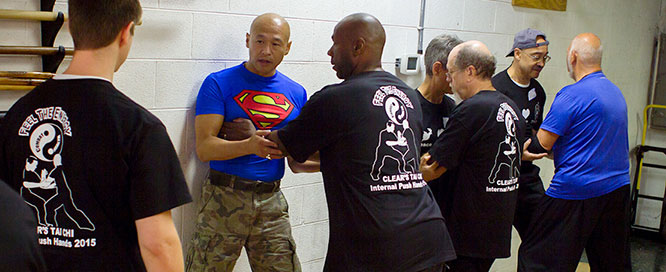
Don’t let this Tai Chi BS hold back your development.
Many of you have met long term Tai Chi practitioners who cannot use their art.
…and these aren’t just your “health only” Tai Chi hobbyists. Many folks who study seriously and have skilled teachers find that their hard work is not developing the level of skill and effectiveness they where looking for.
There can be many reasons for this.
…but there’s one problem that is outlined directly in the Tai Chi classics.
According to Wang Tsung Yueh’s text “Tai-Chi Chuan Ching” (18th Century)
“Many persons who have studied Tai-Chi for a number of years have not developed properly and continue to be subdued by others because they have not realized the error in double weightedness.”
– Translated by Jou Tsung Hwa in his book “The Tao of Tai-Chi Chuan.”
Basically, If you make the double weighted error you cannot reach an intermediate level of skill in Tai Chi.
Unfortunately, the classics are cryptically vague in their language on what exactly “double weightedness” means and so there is a lot of BS out there on how to address this problem.
So first, let’s clear up some of the BS about “the error of double weighted:”
It has nothing to do with the pull of gravity.
Weighted in this context has to do with emphasis. It’s using the meaning of “attach value to” or “assign a handicap.” As in “not evenly distributed” or a “weighted statistic.”
It has nothing to do with your stance.
You can be double weighted while standing on one leg just as easily as when standing on two. It’s often easier to be double weighted when on one leg than when on two.
It has nothing to do with your opponent.
You can be double weighted when you’re all by yourself just as easily as when you’re pushing with an opponent. If you respond poorly to their force it can magnify the problems of the double weighted error, but this is merely a magnification of the symptom. Not the problem itself.
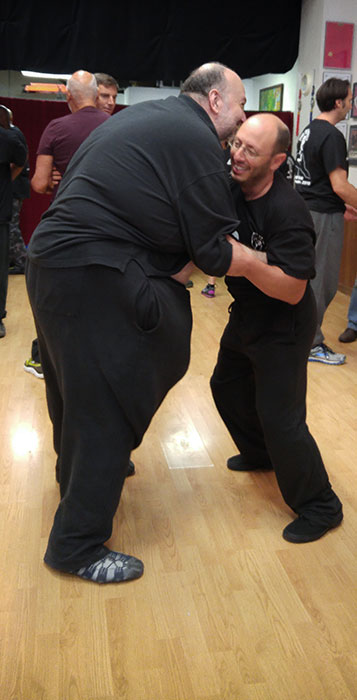
Now, to be fair, some of the above can crop up as symptoms of the double weighted error.
Symptoms can be useful in helping you know when the error is occuring.
…but do not mistake the symptom for the problem.
This is the most common error in the information out there about double weightedness.
Folks take a problem that can be a symptom of the error and mistake it for the error itself.
Unfortunately this won’t help you solve the problem. It only covers up one of many potential symptoms.
Without a full understanding of the double weighted error and all it’s symptoms, you can’t properly troubleshoot and solve the problem.
I’ll try to keep it as simple and practical as possible but the answer requires a bit of explanation.
One reason there’s so much misinformation out there is that this topic is difficult to understand and explain. Especially in a practical, down to earth way. (Of course, the teachers who deliberately hide information compound this problem.)
What does double weighted really mean?
In the Tai Chi classics the term “double weighted” pops up in this context:
“Many persons who have studied Tai-Chi for a number of years have not developed properly and continue to be subdued by others because they have not realized the error in double weightedness.”
The above translation of Wang Tsung Yueh’s text “Tai-Chi Chuan Ching” is from The Tao of Tai-Chi Chuan by Jou, Tsung Hwa.
Master Jou goes on to describe this to mean that Tai Chi practitioners fail to follow the basic principles of Tai Chi.
The key basic principle that is being violated here is described in “The theory of Tai-Chi Chuan” Attributed to Chang San-feng (est. 1279 -1386)
“One must distinguish substantial from insubstantiality. Where there is substantial, there must be insubstantiality. In all ways, one has to distinguish one from the other.”
…and you’ll find this idea crops up in various forms in many of the classic writings on Tai Chi.
You must differentiate between substantial & insubstantial.
…a failure to make this distinction is to make the error of double weightedness.
It’s interesting to note that the character often translated as “weighted” 重, is also associated with meanings like repetition, iteration, a layer, emphasis.
If we talk about a statistic or a test being weighted, we mean that it’s artificially skewed towards a specific result.
So to be doubly weighted is to over emphasize something or make an over commitment in some way.
A better translation within the context of Tai Chi Chuan is:

“The error of paired repetition”
or “the error of double layers”
or, even better:
“the error of double emphasis.”
…and you do see some teachers talk about making the error of “double yang” or “double yin.”
Which is another way of talking about this idea.
But what the hell does all this mean in practical terms?!
It’s easy to throw these terms around and quote the classics all day without giving anyone something useful that they can take home & implement in their own practice.
..and unfortunately many teachers do this, whether it’s to hide their ignorance or to withhold information and knowledge from their students. I don’t know.
How to prevent the error of double weightedness.
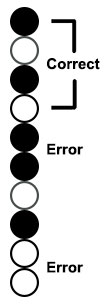
So, what does this mean in practical terms?
Think about your spine.
It’s made up of layers, and these layers alternate between somewhat solid and somewhat less solid.
These alternating layers of tissues are an example of a distinction between substantial and insubstantial.
If some of these vertebrae become fused together it causes problems.
Another example of this, is that to move you must both contract and relax muscles in the body. If you fail to relax the proper muscles or contract the wrong muscles, you can’t move properly or with full power.
…because you failed to create a distinction between substantial and insubstantial in your body.
Of course it’s not quite that simple.
Tai Chi is internal so we’re not just talking about the physical anatomy, we must also make sure we’re not double weighted in the energies and body states we use.
A basic way to do this is to sink the chi into the lower body so that it becomes heavy while the upper body becomes light.
You are now distinguishing between substantial in the lower body and insubstantial in the upper body.
This is a good start (for a day one beginner) but we need to go much further.
…because at this point you’ve essentially divided the body in half with a single distinction.
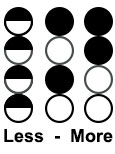
If you go up against someone who can separate heavy and light in the upper body and do it again in the lower body you will lose.
…because they are creating a much more refined distinction between heavy and light in their body than you are.
You are double weighted compared to them.
…of course they will be double weighted when compared to someone who can refine this even further.
Unfortunately, the above example does not paint a complete picture but it’s a good start.
At a more advanced level you can be all light or all heavy and still not be double weighted.
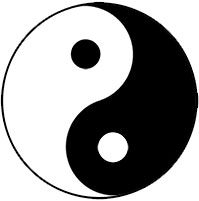
When you understand both the insubstantial and substantial aspects of lightness AND you distinguish between them then you can use lightness effectively.
If you don’t distinguish between the substantial and insubstantial aspects of lightness than you will find lightness to be very weak and your structure will collapse or you’ll be forced to retreat or run into other problems
Of course, light is just one of the many energies of Tai Chi.
There’s light, heavy, empty, full, open, closed, expanding, contracting, spiralling, magnetic, electric, and so on…
The classics say:
“In all ways, one has to distinguish one from the other.”
The key is the first part: “in ALL ways”
Any time you fail to make this distinction, in any way, you are committing the error of “double weightedness.”
As you can see this problem has a massive potential to crop up in all sorts of ways.
…and this distinction between substantial and insubstantial is an ongoing process that you can always refine and get better at.
http://ClearTaichi.Com/fix-it
How to spot double weighted errors and fix them.
Here’s the problem with fixing double weighted errors.
To fix errors you must be able to find them. In Tai Chi we typically do this by feel with the ‘Ting’ skill.
However, a symptom of the double weighted error is that it limits your ability to feel what’s going on inside yourself (and in someone else.)
…and so it’s a bit of a catch 22.
You must differentiate between substantial & insubstantial in order to perceive areas where you are failing to distinguish between substantial and insubstantial.
Excess tension is one example of this. The more tense you are the less you can feel (and the more you are double weighted.)
As you relax, you can feel more and more. However, there are often deep seated areas of habitual tension that are very difficult to find and deal with unless they are pointed out in some way.
So, here’s what you do:
1 Build Ting
Sensitivity drills are of the utmost importance. The more you work on building your Ting the better off you are. But this alone isn’t enough.
2 Look for Symptoms
Use the symptoms of double weightedness to spot and troubleshoot the error.
Some common symptoms include: an inability to instantly shift weight or intention, difficulty perceiving substantial and insubstantial, and excess tension is a common sign of the double weighted error. (though whether tension is the cause or the result of the double weightedness depends on the situation.)
IMPORTANT: Remember that the symptoms are NOT the problem and just because you’ve fixed a couple of the symptoms does not mean that the problem has been solved. So keep working.
3 Internal Push Hands
By far the most effective way to find and fix the error of double weightedness is doing internal push hands with a partner.
A partner will help you find errors you didn’t know you had and rapidly speed up your progress.
A key part of becoming a Clear Push Hands instructor is learning to distinguish substantial and insubstantial and learning how to find and prevent the double weighted error.
And while I don’t have time to get into it on this article-
I have a FREE online course, The Practical Guide to Internal Power that will help you find what you’ve been missing.
I hope this article has been a big help to understanding a very confusing topic.
I’ll see you next time-
And remember-
Keep Training!
-Sifu Clear

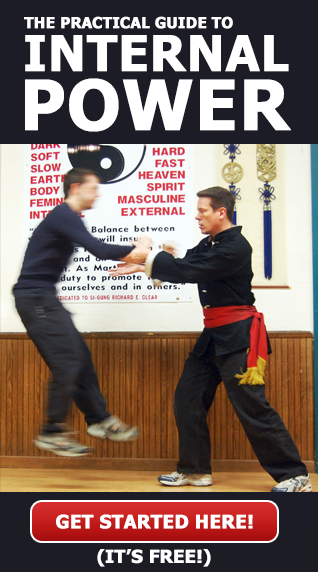
Just so you know, 重 has two different pronunciations, each with its exclusive meanings: ㄓㄨㄥˋ (zhong4) has a bunch of meanings, including weight, all of which could perhaps be said to have some sense of intensity or over the limit; ㄔㄨㄥˊ (chong2) deals with repetition (as a noun, a verb, an adverb).
I could make a bad analogy to words in English that change their pronunciation depending on whether they are a noun or a verb:
“I would like to present you with this present.”
“When did they record that record?”
The difference here is that if you pronounce 重 one way, you could get weight, but not repetition. Pronounce it another way and you could get repetition, but not weight.
Hope my comment wasn’t too pedantic : )
Greg
You make a great point. This is one of the challenges with translation. Especially something old like this. To make matters worse many of the teachers I know are the type who will switch between pronunciation and meaning depending on the point they are trying to convey. both of which could be correct in the right context.
I like how weight is an existential quality and repetition is temporal quality, like a frequency. I could see performing a technique fluidly from beginning to end as a form of proper repition because you did not stop or break on the way through, so it’s a whole technique like a person’s body would be whole when they’re properly weighed alternating substantial and insubstantial.